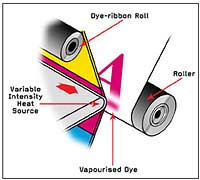Sublimation Dyes are not the dyes that has a distinct
chemical structure, but a popular variety of dye that has printing
applications. It is readily available in the market as inkjet ink, toner
for laser printers, or as ribbons for the thermal-transfer printing.
Sublimation dyes typically range from the following class of dyes, Acid,
Vat, Pigment, Disperse, Direct and Reactive Dyes. Mostly Disperse and
Direct Dyes gets the choice of printers as formulations of sublimation.
These dyes are prepared from the chemical class of organic systems that
is known as azo, anthroquinone and phthalocyanine dye systems.
Preferred sublimation dyes consists of ideally a four to eight color
sublimation ink sets. The term "sublimation" has an
interesting meaning. It is the process where the solid changes into a
gas directly, without undergoing the normal liquid phase in between. So
does the sublimation dyes gets converted into gas from solid state as a
result of the heat-transfer process. On applying heat and pressure, they
subsequently get absorbed into polyester or acrylic materials as the
case may be. Sublimation dyes forms durable and virtually permanent
images. It has been seen that at approximately 325 degrees when
polyester molecules open up. In the transfer process, the dye gets
converted into gas. It is this gas that is able to bond with the
synthetic fabrics.

The way in which sublimation dyes are used for
producing the " transfers" varies with the equipment type.
Here the most common approach using a dye sublimation printer is
described.

The basic difference between dye sublimation and other types of
printing is option of heat. It is the vaporised colours that permeates
the surface of the paper. This creates an effect of gentle gradation at
each pixel edges. While in the case of inkjets there is a visible border
between dye and paper. In dye sublimation, as the colour infuses the
paper, vulnerability to fading and distortion is lower.


